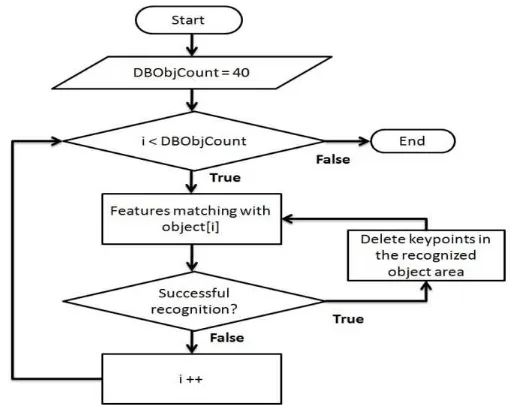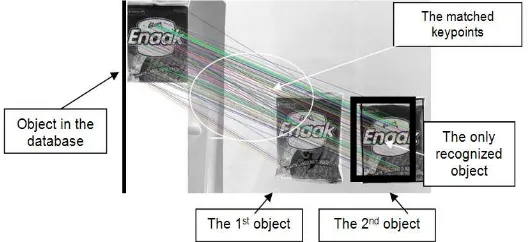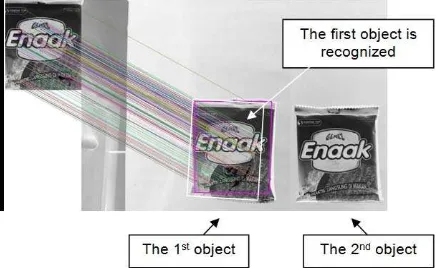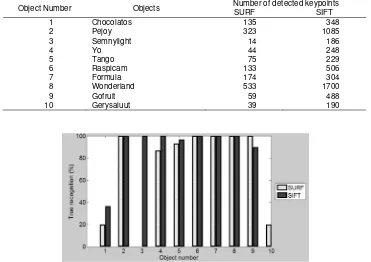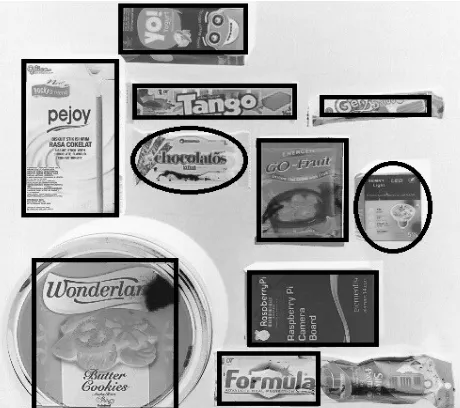DOI: 10.12928/TELKOMNIKA.v14i1.3461 692
Features Deletion on Multiple Objects Recognition
Samuel Alvin Hutama, Saptadi Nugroho, Darmawan Utomo* Electronic and Computer Engineering Faculty, Satya Wacana Christian University,
Jalan Diponegoro 52 – 60 Salatiga 50711, (+62298) 311884 *Corresponding author, e-mail: [email protected]
Abstract
This paper presents a multiple objects recognition method using the SURF and the SIFT algorithm. Both algorithms are used for finding features by detecting keypoints and extracting descriptors on every object. The randomized KD-Tree algorithm is then used for matching those descriptors. The proposed method is deletion of certain features after an object has been registered and repetition of successful recognition. The method is expected to recognize all of the registered objects which are shown in an image. A series of tests is done in order to understand the characteristic of the recognizable object and the method capability to do the recognition. The test results show the accuracy of the proposed method is 97% using SURF and 88.7% using SIFT.
Keywords: multiple object recognition, SURF, SIFT, randomized KD-Tree
Copyright © 2016 Universitas Ahmad Dahlan. All rights reserved.
1. Introduction
Object recognition can be accomplished using feature-based algorithms. The process is divided into two parts, feature detection and feature matching. Feature detection is a process of detecting keypoints of an object and extracting them into descriptors so that they can be matched. This process can be solved using many algorithms, such as SURF [1], SIFT [2], or Zernike moments [3]. There are two phases of feature detection, training phase and testing phase [4]. All objects features detected in the training phase are saved in database. Feature matching is a process of comparing features detected in the training phase with the features detected in the testing phase. Object recognition accuracy depends on the detected keypoints, extracted descriptors, and the matching process [5].
Multiple object recognition can be achieved using many methods, such as using different object detectors simultaneously [6], segmenting image using the SLIC superpixels method [7], sliding window method, or a hierarchical pyramid structure [8] which almost works the same way as the sliding window method. Another different method such as in crowd counting also can be used by applying Linear Interpolation for camera distortion calibration [9], while multiple brands in images can be done using sliding window method [10].
The most problem while implementing sliding window is that the recognition times become slower after each image division. In this paper, we propose a simpler method which is done by just deleting features of recognized objects in one image processing and then repeating the recognition based on the keypoints without any repeated image segmentations.
From the original SIFT or SURF, we only can get keypoints of one image. To find one inquiry object (I) in one image (S), both images need to be processed to yield keypoints. Then by matching I-keypoints to the S-keypoints using Randomized KD-tree [11], similarity between two objects can be reached. From the last processing, it turns back one of three results namely a true recognition, false recognition, or not found. If there are two objects I in S, both SIFT and SURF only shows one matched. To solve this problem, we propose a technique to recognize multiple objects that fast and also can identify multiple identics objects that lay on S.
2. Research Method
one by one using SIFT and SURF algorithm and their detected and extracted keypoints are saved in database. To identify multiple objects in an image (S), every I-keypoints is matched with S-keypoints. The following sections describe how the multiple objects recognitions without and with features deletion.
2.1. Multiple Object Recognition
Multiple different-object (non identics) recognition shown in Figure 1 is a process that only one object of the same brand is recognized regardless of their occurrences in an input image. However if in one image (S) contains non identics brands, almost all of the brands will be found. This is one of the characteristics of the original SIFT and SURF algorithms.
Figure 1. Multiple different-objects recognition
To identify multiple identics and non identics objects, we propose an idea as shown in Figure 2, that is by deleting keypoints located in the found-object area after first loop searching. The process is then repeated by feature matching again until no feature is left. The next section will discuss how this idea works fast and without repeating recognition processing from the beginning.
2.2. Features deletion
From Section 2.1 have been described that multiple objects recognition consists of multiple different-objects recognition and multiple identics-objects recognition. In order to realize the multiple identics-objects recognition process, the following steps are needed to be done. 1. Objects which will be recognized are registered by saving the detected keypoints and the
extracted descriptors in the database. Figure 3 shows the keypoints of a chosen object registered in database.
Figure 3. The detected keypoints of the object registered in database are represented in dots
2. Features of an input image can be found by detecting keypoints and extracting descriptors using SURF or SIFT. Figure 4 shows an example of the input image. The presented image is made negative just to make it clear. The image consists of two identics objects which need to be recognized.
Figure 4. Two identics objects in the input image.
3. Descriptors in the input image are compared to the descriptors of the registered objects. The original SIFT/SURF algorithm will only recognize one object regardless how many times the process is repeated. Figure 5 shows that only the second object is recognized because most of the keypoints of this object are matched with the keypoints of the identics object in the database.
4. Figure 6 shows the region of interest (ROI) marked in white area. Features located in this ROI belong to the second object. Therefore, they will be deleted since they have been matched in the first-loop recognition process.
Figure 6. The keypoints collection of the second object are located in ROI and surrounded within the white area.
5. The features in the ROI are deleted by nullifying the descriptors. It can be seen from Figure 7 that there are no features in the ROI. Then, by repeating step three, the first object is finally recognized. Figure 8 shows that after deleting features and repeating the third step.
Figure 7. The ROI without features
Figure 8. The first object is finally recognized.
3. Results and Analysis
The object characteristics and the system performance tests are run on a laptop using Intel® Core™ i5-4200M CPU @ 2.50GHz Processor and 2.00 GB of RAM.
3.1. Objects Characteristics
Object characteristics can be classified as size, shape, and pattern of the object. These characteristics give different number of detected keypoints. Different number of detected keypoints will affect the features matching result. A true recognition is a condition where an object in the testing phase is recognized based on the identical object in the training phase.
The 10 registered objects shown in Table 1 are chosen based on their difference in characteristics. They are tested 30 times in order to find the minimum number of keypoints needed to obtain the true recognition rate above 80%.
Table 1. Objects with different characteristics give different number of keypoints
Object Number Objects Number of detected keypoints
SURF SIFT
Figure 9. True recognition on 10 chosen objects using SURF and SIFT algorithms
Figure 9 shows that object number 4 has a true recognition rate above 80%. From Table 1, this object has 44 keypoints. This concludes that the success factor is not limited on the number of keypoints.For example, object number one has 135 detected keypoints using SURF but the recognition result is below than 50%. It can be understood that external factor such as light reflection on the object also affect the true recognition rate. Figure 10 shows that some part of the object number one is hidden because of light reflection, therefore making features detection inaccurate. In general, the recognition result above 80% can be reached if the keypoints are more than 44 and object not giving too much reflection.
3.2. The Method Performance
Figure 10. Object number one
Table 2. Result of the method performance test Number of truly recognized
objects
Number of capturing an image using SURF
Number of capturing an image using SIFT
( ) (times) (times)
6 0 0 1 6
7 1 7 3 21
8 1 8 7 56
9 4 36 7 63
10 24 240 12 120
Total 30 291 30 266
True Recognition ( ) = 97% = 88.7%
Misdetection ( ) 3% 11.3%
TR and MD in Table 2 are calculated using the following equation.
∑
% (1)
∑
% (2)
% % (3)
In the Table 2, 10 objects ( ) can be recognized well 24 ( ) and 12 ( ) times using SURF and SIFT algorithm consecutively. Moreover, from 300 objects, SURF gives 97% success recognition. This is 8.3% better than SIFT.
Figure 11 shows the result of multiple object recognitions using features deletion method. To make the result clear, the image is shown in negative, the black-box rectangles are befall on the original rectangle results, and the two ellips are added to show the unrecognized objects. The eight recognized objects can be seen within the bold black rectangles. While two objects can not be recognized because of reflections as in object number one and small number of keypoints as in object number three.
4. Conclusion
Multiple objects recognition can be realized using the features deletion method. Features in the testing phase are compared to all features in the training phase. Features in recognized object are deleted before the recognition process is repeated. Higher number of keypoints will gives higher true recognition rate. External factor such as light reflection also affect the true recognition rate. The test results in this experiment show that an object is recognizable if there is a fixed part of the object which has more than 44 keypoints. The accuracy of the proposed method based 40 registered objects and 30 times test is 97% using SURF and 88.7% using SIFT.
References
[1] H Bay, A Ess, T Tuytelaars, LV Gool. SURF: Speeded Up Robust Features. Computer Vision and
Image Understanding. 2008; 110(3): 346-359.
[2] DG Lowe. Distinctive Image Features from Scale-Invariant Keypoints. International Journal of
Computer Vision. 2004; 60(2): 91-110.
[3] Saptadi Nugroho, Darmawan Utomo. Rotation Invariant Indexing For Image Using Zernike Moments
and R–Tree. TELKOMNIKA Telecommunication Computing Electronics and Control. 2011; 9(2):
335-340.
[4] M Murai, S Tade. Multi-vie object recognition using Feature detection & descriptor algorithms.
International Journal of Engineering, Education and Technology (ARDIJEET). 2015; 3(2).
[5] PM Panchal, SR Panchal, SK Shah. A Comparison of SIFT and SURF. International Journal of
Innovative Research in Computer and Communication Engineering (IJIRCCE). 2013; 1(2): 323-327. [6] K Khurana, R Awasthi. Techniques for Object Recognition in Images and Multi-Object Detection.
International Journal of Advanced Research in Computer Engineering & Technology (IJARCET). 2013; 2(4): 1383-1388.
[7] M Lopez-de-la-Calleja, T Nagai, M Attamimi, MN Miyatake, HP Meana. Object Detection Using
SURF and Superpixels. Journal of Software Engineering and Applications. 2013; 6: 511-518.
[8] D Schmitt, N McCoy. Object Classification and Localization Using SURF Descriptors. Citeseer. 2011.
[9] H Zhang, H Gao. Large Crowd Based on Improved SURF Algorithm. TELKOMNIKA
Telecommunication Computing Electronics and Control. 2014; 12(4): 865-874.
[10] M Skoczylas. Automatic Recognition of Multiple Brands in Images on Mobile Devices. Advances in
Computer Science Research. 2013; 10: 81-97.
[11] Silpa-Anan C, Hartley R. Optimised KD-trees for fast image descriptor matching. Computer Vision
